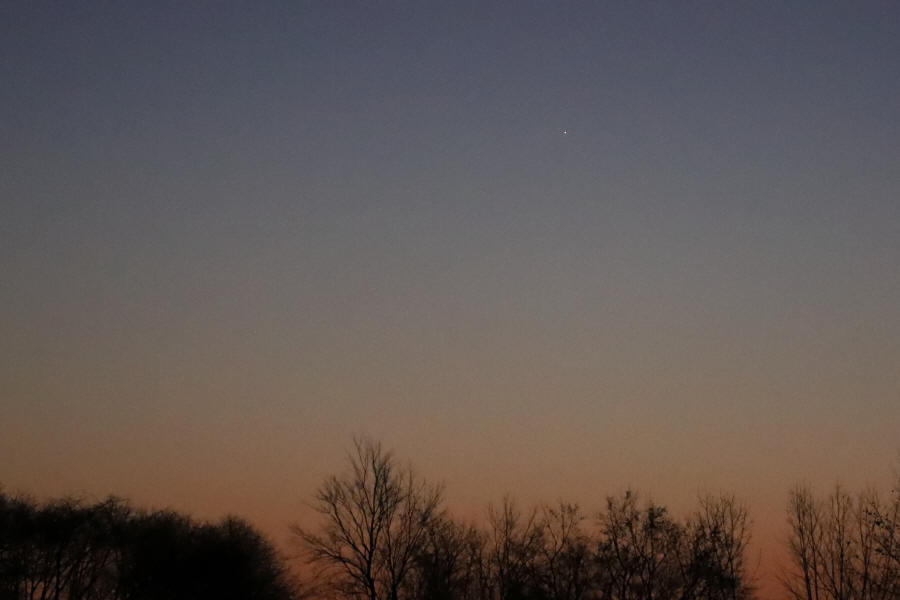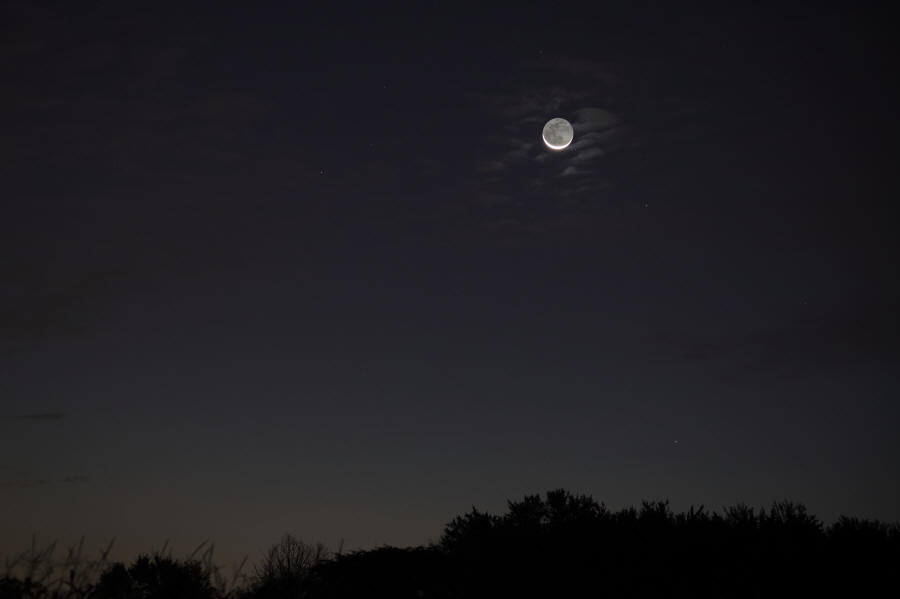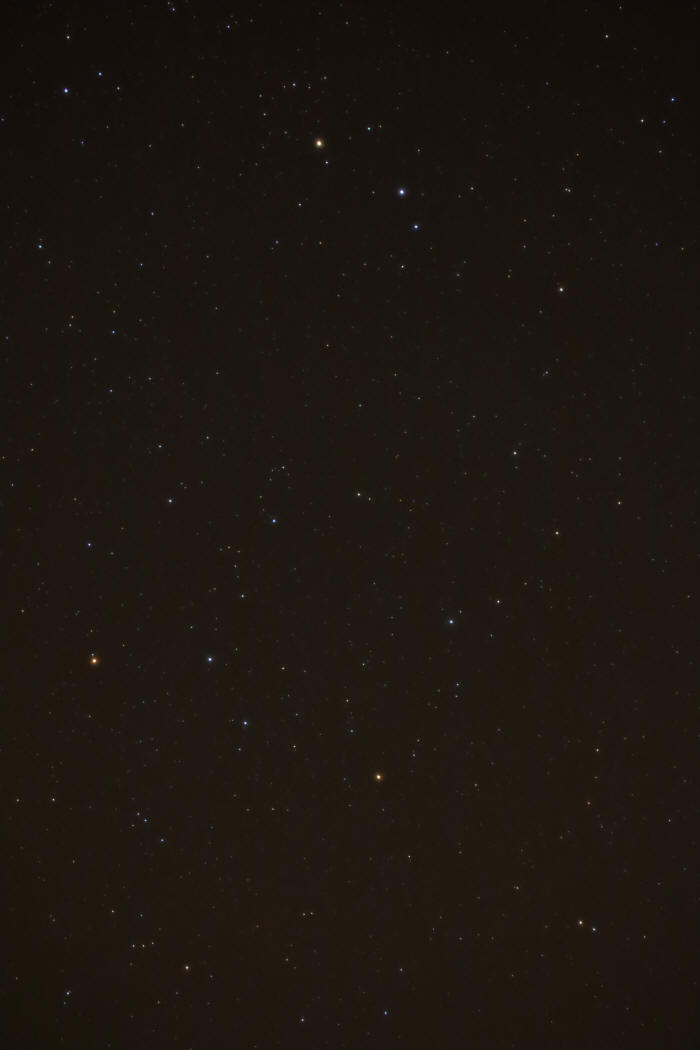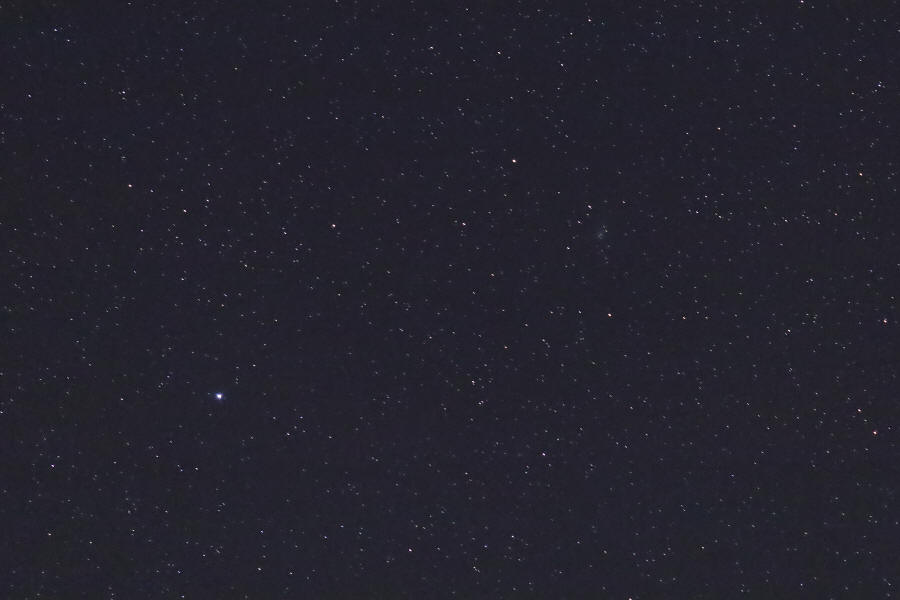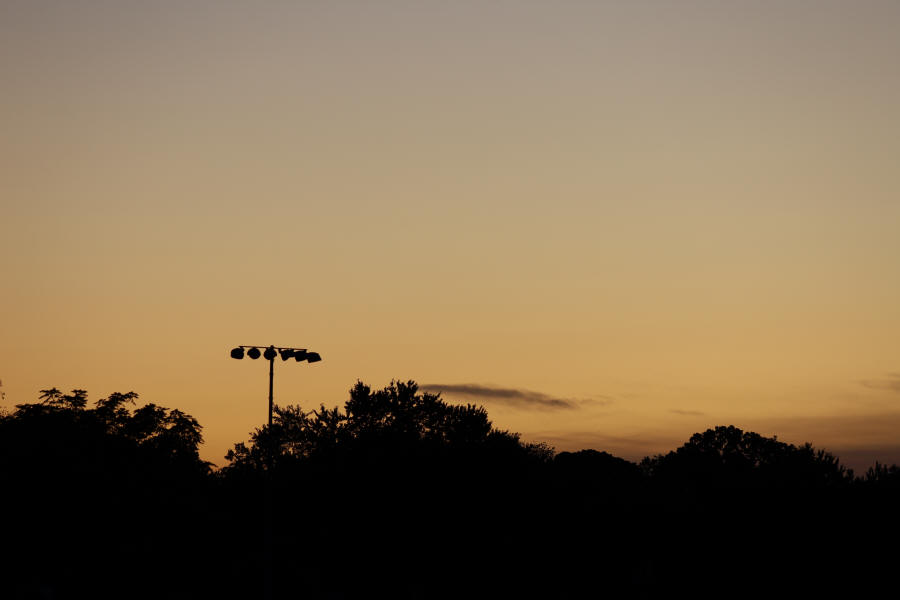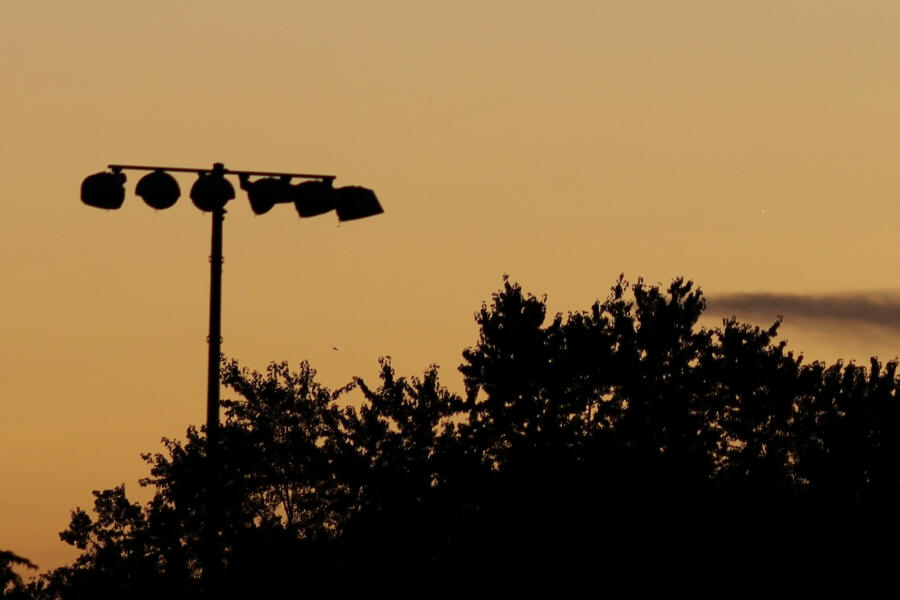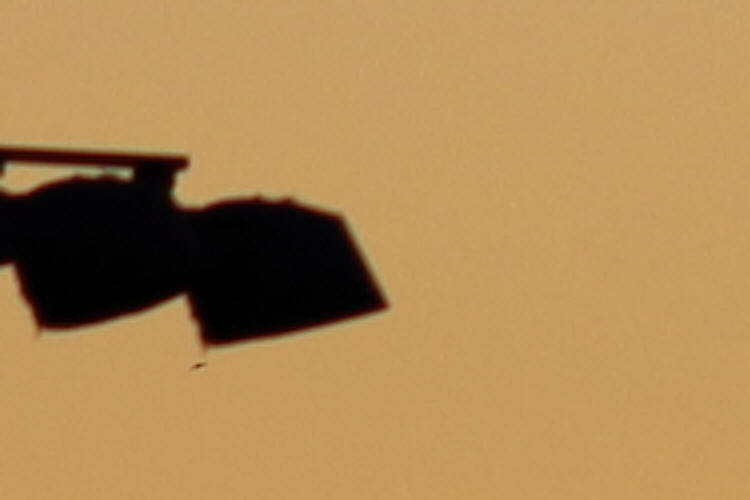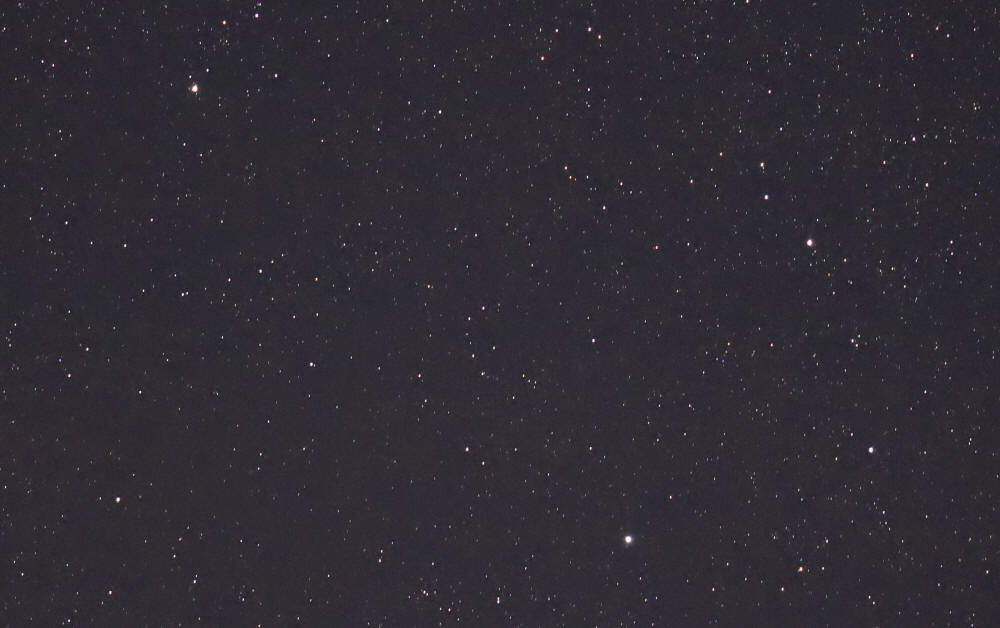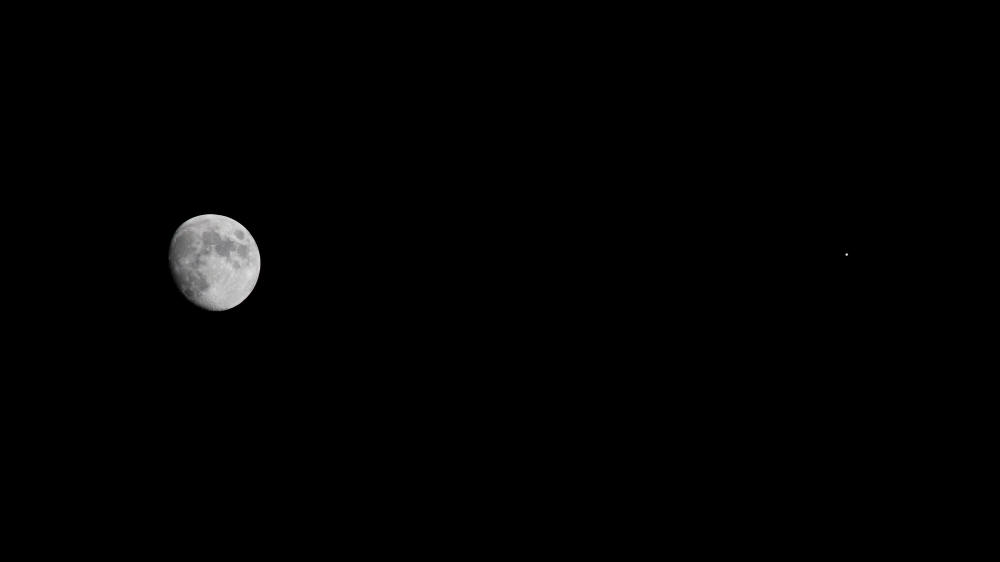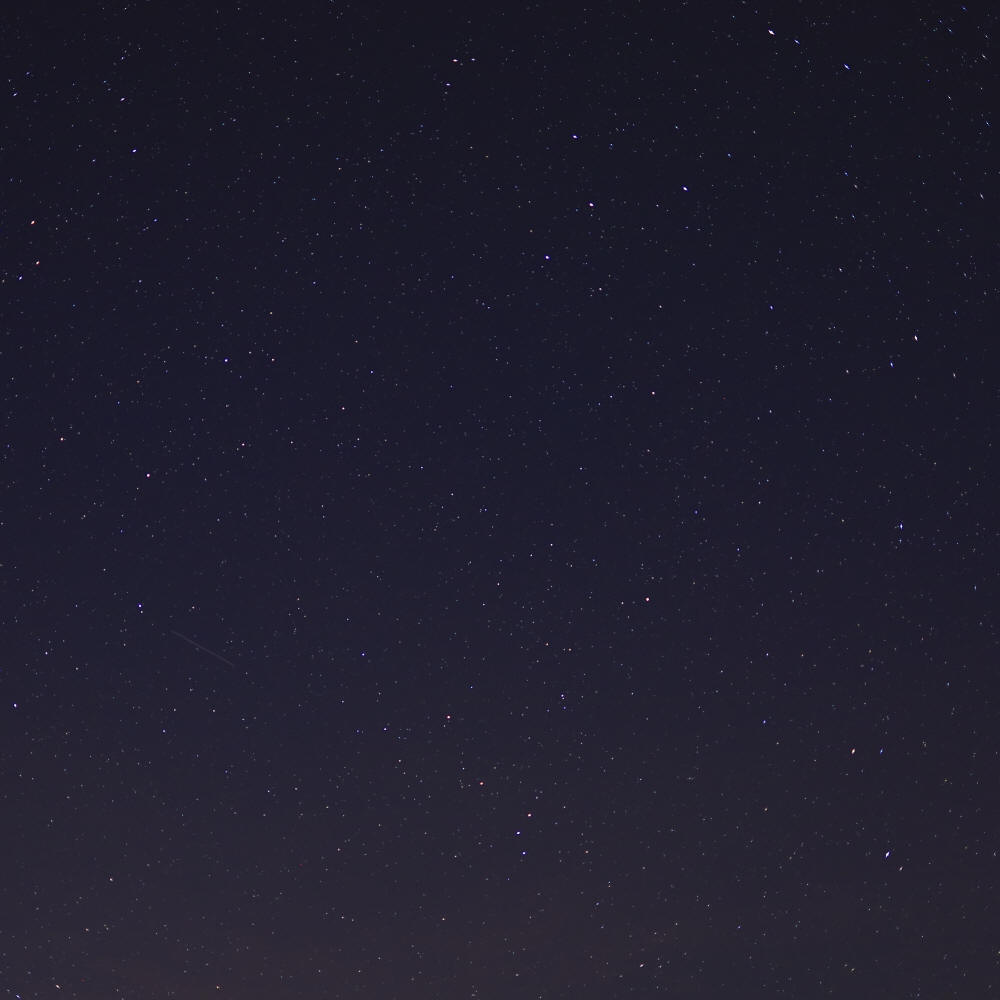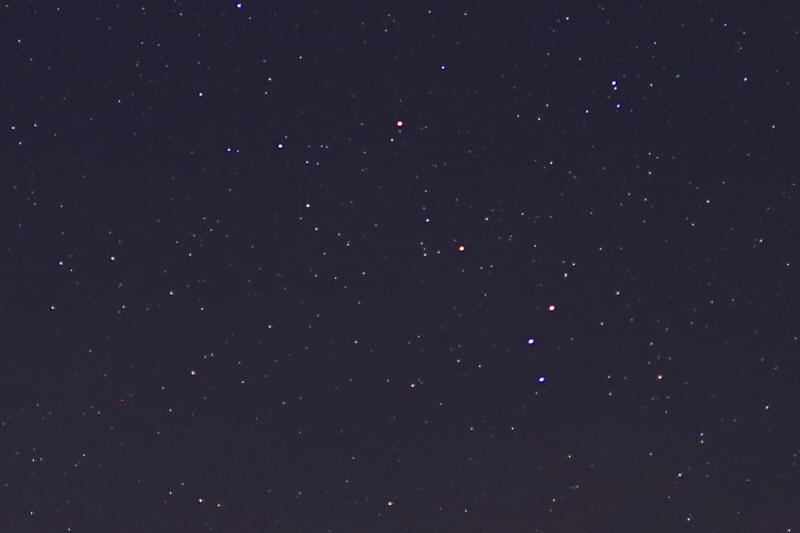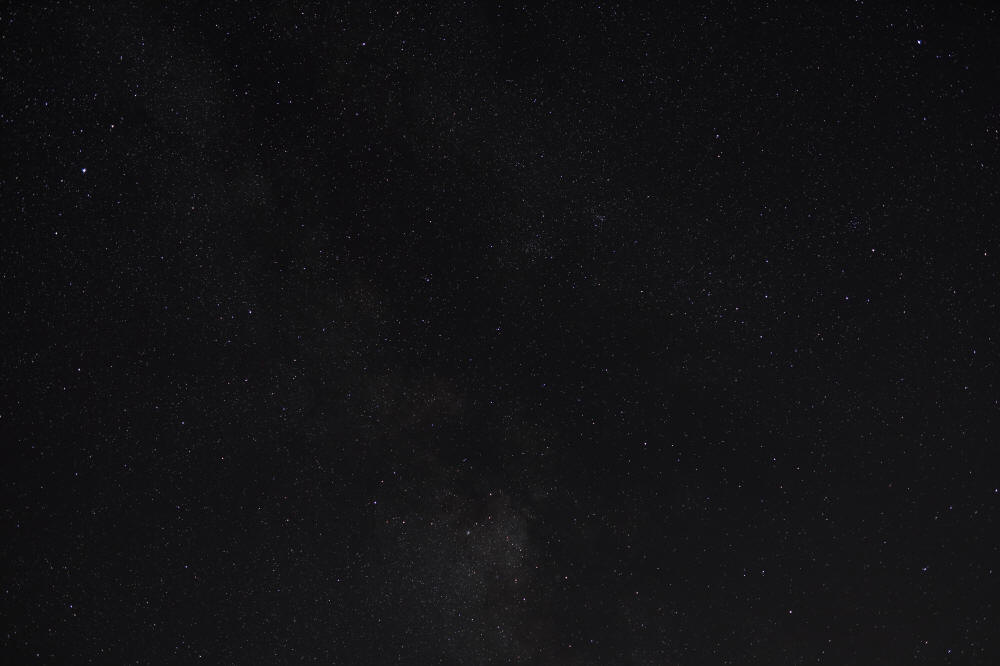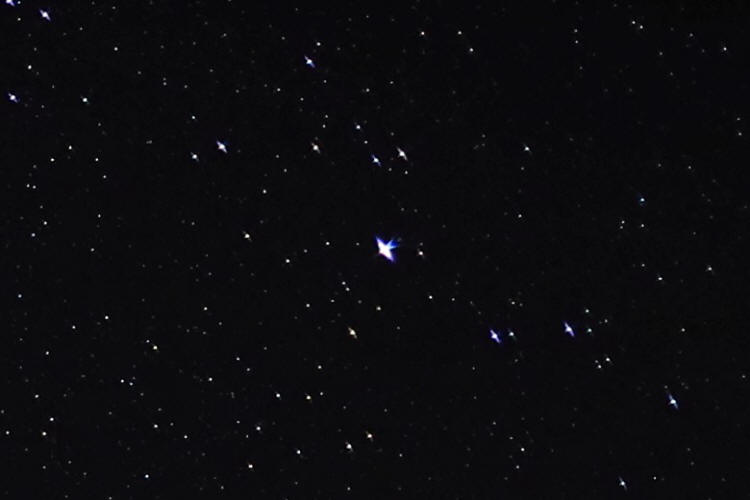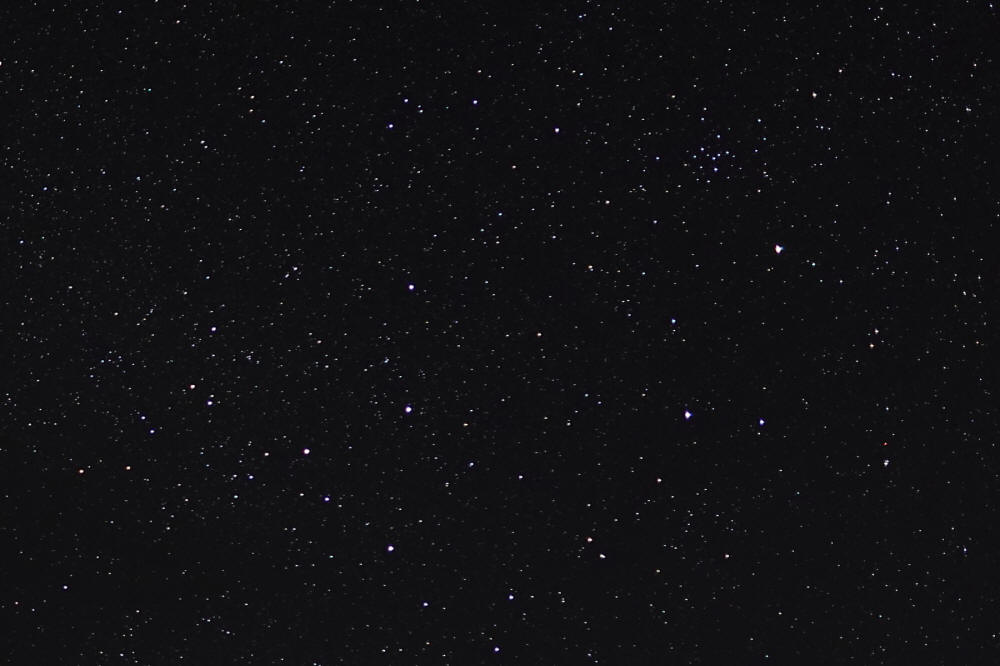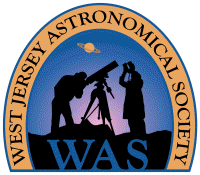SJAstro Page Index
Mercury
November 21, 2019
The planet Mercury was captured on November 21, 2019, at 6:00 am EST from Swede Run in Moorestown, NJ. Taken with a Canon EOS RP mirrorless digital camera (on a fixed tripod) and a Canon 100 mm f/2.8 macro lens. It's a single frame automatically exposed 1/40 second at f/2.8, ISO 12,800, daylight white balance, then cropped to 48% of the original linear dimensions for a field 9.9° wide x 6.6° high. Mercury was easily visible with unaided eyes and it was my first sighting since the solar transit on November 11. It's also the first sighting for the sixth and final elongation of 2019, which is also the fifty-seventh elongation in a row, starting in January 2011, that Mercury has been seen. Both Mercury and Mars were spotted with unaided eyes as soon as I arrived at 5:49 am, which additionally completed a sweep of seeing all seven non-earth planets overnight, Nov 20/21, starting with Venus & Jupiter at 5:20 pm and Saturn at 5:22 pm, with unaided eyes, then Neptune at 8:36 pm and Uranus at 8:40 pm with 15x56 binoculars.
Transit of Mercury
The
Transit of Mercury on
November 11, 2019, was observed initially at Swede Run
in Moorestown, NJ, and then at Merchantville, NJ. This is the first
November transit I've seen, previous November transits have been
obscured by bad weather.
Here's a
report (edited 17-Nov-2019). Also refer to the
Mercury 2019 page for transit
time and circumstance predictions.
The Old Crescent Moon
November 11, 2019
October 26, 2019
The old crescent Moon, filled with earthshine, was captured on
October 26, 2019, at 6:17 am EDT from Swede Run
in Moorestown, NJ. Taken with a Canon EOS RP mirrorless
digital camera (on a fixed tripod) and a Sigma 70 to 300 mm f/4-5.6 zoom
lens set to 108 mm focal length. It's a single frame
exposed 1.6 seconds at f/5.0, ISO 1600. The original raw image was mildly adjusted
in Canon's Digital Photo Professional, and white balance was set to
4000 K. It was cropped to 85% of the original linear dimensions for a
field 16.1° wide x 10.8° high. Mouseover for labels.
At the time, the 4.2%
illuminated Moon was 27.66 days old following New Moon on September 28,
2019 (2:26 pm) and is 1.72 days (41 hr 21 min) before New Moon on
October 27, 2019 (11:38 pm). This morning, the Moon rose at 5:16 am,
astronomical twilight began at 5:51 am and the sun would rise at 7:22
am. Tomorrow morning, October 27, the Moon will rise about
seventeen hours before new, which would be a
challenging sighting and a
personal record for me, but the weather forecast is bleak.
The forecast
for Monday evening, Oct 28, looks more promising when the post-new Moon will be 18 hr
25 min old at sunset (6:03 pm EDT for 40°N-75°W). However, the tilt of
the ecliptic at sunset is much shallower in the evening than it is in
the morning this time of the year, so the Moon will be 7° altitude at
sunset (and sinking).
Mira Brightens
This image of the long-period variable star,
Mira (Omicron Ceti) was captured on
October 24, 2019, at 12:38 am EDT from Carranza
Field in Wharton State Forest, NJ (mouseover for labels). Taken with a Canon EOS RP mirrorless
digital camera (on a fixed tripod) and a Tamron 45 mm f/1.8 lens with a
Hoya "Diffuser" filter attached to the front. It's a single frame
exposed 4 seconds at f/2.8, ISO 6400, in a dark, moonless sky. The original raw image was mildly adjusted
in Canon's Digital Photo Professional, and white balance was set to
daylight. It's uncropped for a field
29.9° wide x 43.5° high.
Mira has a period of 332 days and varies from about magnitude 2 to
10, although its typical peak brightness is around magnitude 3.
Mira estimates by AAVSO (slow to load) at the end of
October have already seemed to peak around
magnitude 2.5, and by October 26, may be trending back to magnitude 3. Bob King has an
observing article
at Sky & Telescope online (posted 16-Oct-2019) that
includes Mira.
Wikipedia (citing SEDS as a reference) lists 24-October-2019 as the date
for the current peak, while the RASC Observer's Handbook 2019
lists
13-Nov-2019 (pg 299). So take a look and keep looking!
I made my first observation of Mira for the coming peak on 11-Oct-2019
from my suburban backyard. It was easy to see in 10x42 binoculars
(showing a definite yellowish-reddish color), and I could also see it
with unaided eyes (but no particular color) if I blocked the nearly-full
moon with my hand and outstretched arm. I've repeated the sighting in
suburban skies several times since then. In contrast, it was easily seen
with unaided eyes on October 24 in the dark sky at Carranza. Here's a
labeled
version of the image showing the path I use to find Mira starting at
the easily-seen Aries stick figure.
C/2018 W2 (Africano)
Comet
C/2018 W2 (Africano), in the constellation
Pegasus, was observed again on
September 26, 2019, at 1:55 am EDT from Carranza
Field in Wharton State Forest, NJ, initially with 15x56 binoculars and
then with a Kowa 88 mm apo spotting scope at 25 to 60x. This nominal
magnitude 8.5
comet was not difficult to see with either the binoculars or the scope,
and movement was clearly noted in the binoculars during the approximate
hour from the first to last observation. This image was
captured at 2:11 am with a Canon EOS RP full-frame, mirrorless digital
camera and a Canon EF 200 mm f/2.8L lens on a fixed tripod. It's a
single frame exposed 4 seconds at f/2.8, ISO 6,400, 3,800K white
balance. It was cropped to 72% of the original size for a field 7.4° wide x
5.0° high, then reduced in size for this
page. The raw image was mildly processed and saved as a JPEG in Canon's
Digital Photo Professional. Mouseover for labels.
The graphic below is a screen clip from SkyTools showing the position of
comet C/2018 W2 (Africano) at hourly intervals beginning 12:50 am EDT at
the top. The middle position represents my initial sighting (about 1:50
am), the bottom position my final sighting (about 2:50 am). The image
above would be between the middle and bottom. The center-to-center span
from the top to bottom comet positions is about 18 arc minutes from NNE
to SSW.
Venus and Mercury
Although they can't be seen in this full-frame image of the planets
Venus
Venus was at superior conjunction on August 14,
2019, and was first seen for this elongation on August 24, 2019, at
2:07 pm EDT with 15x56 binoculars when it was 3.2° east of the sun (the
sun was blocked by a solar panel on a utility pole at the baseball field
complex). Mercury was at superior conjunction on September 3,
2019, and has not been seen visually yet (and I wouldn't count this vague
image capture of
it for my Mercury sighting streak).
Update, Sept 17:
At 7:15 pm EDT, Mercury was spotted visually at the baseball field
complex with an 88 mm apo spotting scope set to 25x; see the
Mercury 2019
sighting page.
This is a 30% crop of the original raw image
providing a field 3.1° wide x 2.1° high (no other adjustments besides
resizing for this web page). Venus is now visible, but not
obvious (mouseover for labels). The dark specks below the light
fixture are probably birds or bats in the distance.
October 24, 2019
September 26, 2019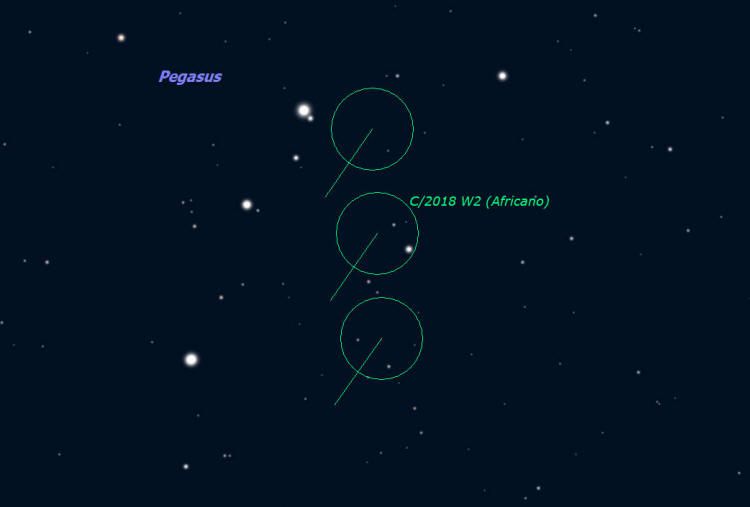
September 15, 2019
This is a 6% crop of the original raw image providing a field 0.6° wide x 0.4° high (again, no adjustments besides cropping and resizing). Mercury is now just barely visible (mouseover for labels). I could not find the speck of Mercury on this image just by inspection, I had to use a ruler and measure its position left of Venus by the proportionate amount of their angular spacing and the angular width of the image.
C/2018 W2 (Africano)
Comet
C/2018 W2 (Africano) in the constellation
Perseus was observed again on
September 4, 2019, at 12:25 am EDT from Carranza
Field in Wharton State Forest, NJ, with a Kowa 88 mm apo spotting scope
and a 25 to 60x zoom eyepiece (best view at 40x). This magnitude 10
comet was barely detectable as a very dim patch of haze, but I was able
to pinpoint the location before I looked at my finder charts prepared
that afternoon, so I'm confident I really did see it. This image was
captured at 12:58 am with a Canon EOS RP full-frame, mirrorless digital
camera and a Canon EF 200 mm f/2.8L lens on a fixed tripod. It's a
single JPEG frame exposed 4 seconds at f/2.8, ISO 12,800, 4,000K white
balance. It was cropped to a little less than 50% of the original size
for a field about 4.9° wide x 3.1° high, then reduced in size for this
page. It was otherwise
unprocessed. At the time
of the sighting, and this image, the comet was in Perseus' cap, a
triangle marked by the stars Gamma, Eta and Tau Persei. Mouseover
for labels.
Here's a real astrophoto of Comet Africano in the same area taken
12½ hours earlier by Mikhail Maslov. It moved about half a degree during
the interval.
September 4, 2019
C/2018 W2 (Africano)
This is not my image of comet
C/2018 W2 (Africano), which at the time was in the constellation
Camelopardalis, not far from Perseus'
triangular cap. As indicated at the bottom of the image, it was
captured
by Eric Bryssinck on
August 29, 2019, at 23:05 UT (7:05 pm EDT) from
Belgium. However, it does show the starfield near the comet as I
observed it on August 29/30, 2019, around midnight, at the Barnegat Rd
site with my 16-inch Dob. The comet was just a faint patch of haze,
first seen at 11:45 pm with an 18 mm eyepiece (101x, 0.81° TFOV).
Mouseover for labels, which shows the observed position at 12:30
am. Motion could be detected during the period of observation; at the
time, it was moving at a rate of 1.7"/minute. This comet was discovered
on November 27, 2018, by B. M. Africano of the Mt. Lemmon survey. Comet
Africano is mentioned in Bob King's online Sky & Telescope article,
Comets to Catch in 2019 (scroll down).
Mercury
This image of planet
Mercury in the constellation
Cancer was captured on
August 10, 2019, at 5:12 pm EDT from Swede Run
in Moorestown, NJ, with a Canon EOS RP full-frame, mirrorless digital
camera and a Canon EF 200 mm f/2.8L lens on a fixed tripod. It's a
single JPEG frame exposed 1/8 second at f/8.0, ISO 12,800, uncropped and
unprocessed. At the time
of the image, Mercury was at 6.1°
altitude, 70° azimuth. The field of view is 10.3° wide x 6.9° high. Mercury was
not difficult to see with unaided eyes, and this is the
second sighting of the fourth
elongation this year (the 55th elongation in a row overall, starting in
January 2011).
In the foreground, there are nearby, out-of-focus tassels at the top of
the corn crop currently planted in the fields around the Swede Run
public area, with some more distant trees behind them. The corn must be
six feet tall now, and to some extent, blocks the view along the
horizon. In previous years, they planted soybeans, which only get a
couple of feet high.
An Unusual ISS Pass
The chart above was generated by
Heavens-Above
and shows the International Space
Station (ISS) pass as seen from
40°N-75°W (close to my Maple Shade, NJ, home) on Monday evening,
July 15, 2019, with Eastern Daylight Time
indicated (nominally around 10:30 pm EDT). I describe it as "unusual"
because I do not recall in the past having seen the ISS disappear into
the earth's shadow shortly after rising, and then reappear
from the shadow shortly before setting on the same pass. I've seen it
disappear into, or appear out of the earth's shadow many times, but to my
best recollection, never both on the same pass!
Anyway, about 10:28 pm, SkySafari on my iPad popped up a notice
that the ISS was rising, so for a change, I actually opened SS and took
a quick look. I saw it rising on-screen in the southwest, so I decided
to go outside for a visual check. I stepped out the front door at 10:29
pm and had to walk a couple of houses down the street to avoid trees and get a decent
view towards the southwest. I looked and looked (hopefully for a bright
object), then finally found a relatively dim satellite rising from the
southwest, roughly at 35-40° altitude. There were thin broken clouds,
but by comparison to visible stars, I estimated it to be around first
magnitude (perhaps +1 to +1.5). It continued upwards and peaked in Lyra
near the Hercules border, then descended towards the northeast, but
disappeared into clouds. Ironically, the ISS was only seen between
the track segments on the H-A chart above, not on them.
I've never seen a high pass of the ISS that wasn't bright (often
brighter than magnitude -3), so seeing it at magnitude +1 overhead was
truly unusual (this four-magnitude difference is equivalent to a 40x
difference in brightness). I suppose it was skimming along the edge of
the earth's shadow to remain relatively dim, but still easily visible at first
magnitude. Normally, the ISS enters the earth's shadow at a steep angle,
then the brightness ramps down quickly as it fades and disappears.
The Moon and Jupiter
This image of the gibbous
Moon
and the planet
Jupiter, both in the constellation
Ophiuchus, was captured on
July 13, 2019, at 9:13 pm EDT from Maple Shade, NJ, with a Canon EOS RP full-frame, mirrorless digital
camera and a Canon EF 400 mm f/5.6L lens on a fixed tripod. It 's a
single raw frame exposed 1/1000 second at f/8.0, ISO 1000, then
minimally processed in Canon's Digital Photo Professional (the only
adjustments were cropping the height to produce a 16:9 ratio and
selectively brightening Jupiter, then conversion to a JPEG). At the time
of the image, the Moon was 92% illuminated, 3.3° from Jupiter
(center-to-center) and both objects were at 25°
altitude in the south-southeast. The field is 5.1° wide x 2.9° high.
Neptune
This image with the planet
Neptune in the constellation
Aquarius was captured on
July 1, 2019, at 1:52 am EDT from Carranza Field
in Wharton State Forest, NJ, with a Canon EOS RP full-frame, mirrorless digital
camera plus a Sigma 50 mm f/1.4 Art lens on a
Skywatcher Star Adventurer Pro
equatorial mount (tracking, but unguided). It 's a single raw frame
exposed 10 seconds at f/1.4, ISO 800, adjusted in Canon's Digital Photo
Professional software, then saved as a JPG. It was cropped to about 59%
of the original width x 88% of the original height producing a field
about 24° square. At the time, Neptune was at 21° altitude.
Mouseover for labels. Bob King posted an
online S&T article about observing Neptune in mid-September 2019.
The image below is a magnifying crop of the
original image to better show
Neptune (25% of the original
linear dimensions for a field 6.4° wide x 4.3° high). Mouseover for
labels.
Test Image from Carranza
This image of the star field from
Aquilla (left),
Ophiuchus (right) and
Scutum (bottom)
includes several notable objects (mouseover for labels). It was captured on
July 1, 2019, at 1:44 am EDT from Carranza Field
in Wharton State Forest, NJ, with a Canon EOS RP full-frame, mirrorless digital
camera plus a Sigma 50 mm f/1.4 Art lens on a
Skywatcher Star Adventurer Pro
equatorial mount (tracking, but unguided). It 's a single uncropped raw
frame (40° wide x 27° high) exposed 20 seconds at f/2, ISO 800, mildly adjusted in Canon's
Digital Photo Professional software, then saved as a JPG. This is first
light for the mount and it seemed to work well with a minimum of fuss.
However, the lens produced some unusual distortions towards the edges of the fame
at the f/2 setting here, even worse at f/1.4. More study is needed,
e.g., trying the same camera and lens at smaller lens openings, and then
the same lens on my EOS 6D at a range of lens openings, to see if it's
the camera (EOS RP) or the lens (50 mm f/1.4), or the combination of the
two.
The image below shows the magnified upper-right corner of the
image above (cropped from the full-size JPG). The brightest star is
The image below is a magnifying crop from the upper-right quadrant of
the original image that includes
Barnard's Star, the star with the
highest-known proper motion (10.3"/year). Mouseover for labels.
Here's a previous SJAstro page about
Barnard's Star.
Click here
for the previous page.
Click here
for an index to previous SJAstro pages.
August 29/30, 2019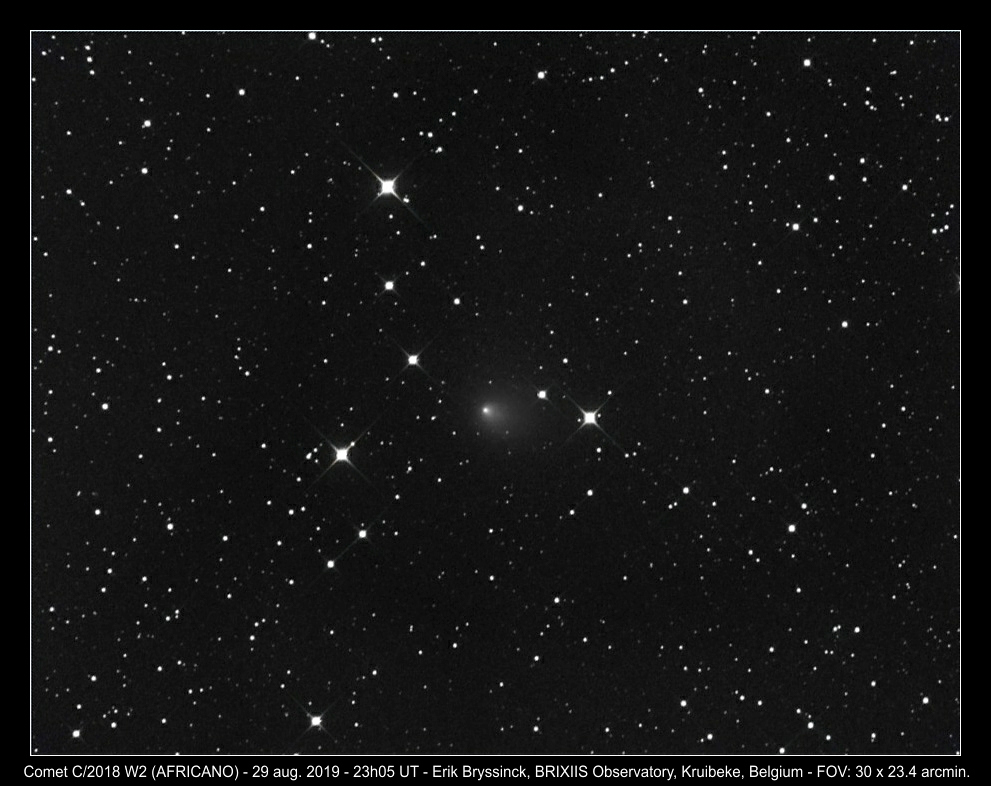
August 10, 2019
July 15, 2019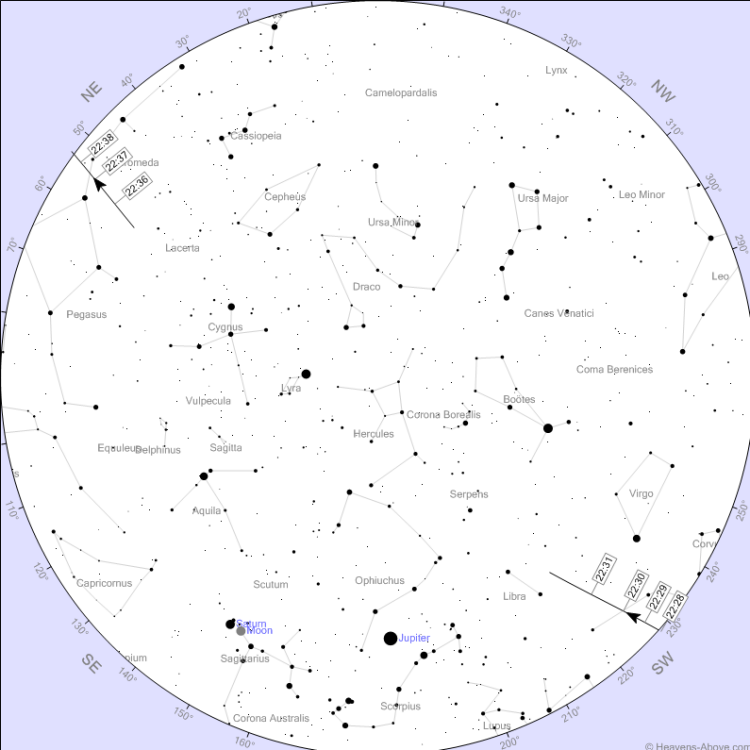
July 13, 2019
July 1, 2019
July 1, 2019
